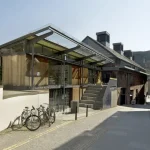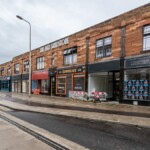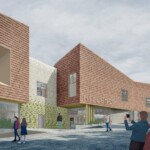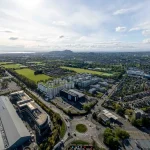Edinburgh Waterfront Symposium, Archigram Event Scotland, Famous architect speakers
Edinburgh Events 2007 : Architecture
Edinburgh Waterfront Workshops
Archigram Event
EDINBURGH – A Symposium on the City in the 21st Century
AiA Art in Architecture and Archigram
Invite you to participate in the first of a series of discussion led debates.
Please confirm your interest to attend by 18 Jun 2007 to [email protected] Tel: 0131 555 2280
The significance of this Introductory 1 Day Event is to set the precedent and generate the impetus to lead a further series of events involving respected international contributors in order to build up a significant body of theoretical design solutions for Edinburgh as a Future City.
Introductory 1 Day Event
Venue: Edinburgh University – Lecture Theatre 1
Minto House, Chambers Street, Edinburgh EH1
Date: Friday 22 June
Main Contributors:
Dennis Crompton – Archigram
Shaeron Averbuch – AiA Art in Architecture
Ross McEwan – AiA Art in Architecture
Terry Farrell – City of Edinburgh Design Champion
Michael Spens – Architect & Historian. Reader/Senior Research Fellow at Dundee University
Pete Barber – Architect
Raoul Bunschotten – Architect and Urbanist
Richard Demarco – The Demarco Foundation
Riccardo Marini – City of Edinburgh Council, City Design Leader
Grahame Shane – Professor Columbia University and Cooper Union, New York
Lorens Holm – Senior Lecturer Architecture, Dundee University
Kathryn Findlay – Professor of Architecture, Dundee University
Matthew Lennon – Pulic Art Officer, Newcastle City Council
Bob Morris – Economic History, The University of Edinburgh
Charles McKean – Writer & Historian
PROGRAMME:
9.30 am Registration
10.00 am Introduction
10.10 am Morning Session, 15 – 20 minute talks by listed contributors
followed by comment and debate
1.00 pm Lunch
2.00 pm Afternoon Session, 15 – 20 minute talks by listed contributors
followed by comment and debate
4.30 pm Summary and Conclusions
SYMPOSIUM
1.0 Background
EDINBURGH is perhaps not unique but it is certainly very special and precious city. Its urban history can be read
most dramatically by observation of the historic medieval Old Town and the New Town of the 18th century Scottish Enlightenment. Its 19th century industrial heritage provides a rugged character in the buildings and their consequent urban spaces, but no longer in their usage. The 20th century commercial and suburban developments are probably, for the most part, best left unmentioned!
The totally amazing determination and conviction in the commissioning of the new parliament building – looking
forward to a democratic, participatory society rather than back to a historic authoritarian, hierarchical rule – gives an indication of a 21st century Edinburgh prepared to engage with an urbanism of a quality to stand alongside the Old and New Towns. The coincidence of the availability of a large area of land in the waterside quarter of the city provides a unique opportunity to fulfil this aspiration of a future city of continuing international significance.
The purpose of this symposium is to stand back from the current pressures of the landowners, the developers and
the master planners and to revisit the basic questions of urbanism in the 21st century in order to explore the
exciting prospects of this future city.
2.0 Intention
Art in Architecture and the innovative sixties Archigram Group have invited a series of personalities to lead the
discussion by first relating their own experiences in the current world of urbanism, architecture and public art.
Discussion seminars will then carry these concepts into detail and expand their scope. The record of these
exchanges will define the main, critical questions and will provided indications of the range of solutions.
3.0 PROGRAMME TOPICS
3.1 Introduction
The Tradition of Cities: Ideal, Pragmatic, Organic — The City as a Reflection of Culture —
The “Urban” Plan — The 19th and 20th Century City — City Structures: Physical, Social, Political,
Economic — The Urban History and Traditions of Edinburgh — Edinburgh Old Town & New Town
3.2 21st Century Cities
Visionary Models — Infrastructures: Macro to Micro — Amenity — Space and Dimensions —
Permanence and Change — Separation, Integration, Layering
3.3 Edinburgh: New Waterfront City
Communities and Neighbourhoods — Demographics — Participation — Regeneration —
Sustainability — Efficiency — Urban Form — Experiment / Getting it wrong
Infrastructure — Lange and Intimate scale — Public and Private Space — Amenity — Access
Transport (Public & Private) —Movement (Traffic but also other forms + Vertical)
Communications (non physical) — Interaction — internal response — Interaction: with the greater city
Servicing and Maintenance — Housing — Shopping/Supplies — Education
Health and Welfare Services — Employment — Recreation — Tourism — Entertainment
3.4 URBAN LANDSCAPES
In-city and Waterfront — Natural + Cultivated — Public + Private — Scales — Access —
Boardwalk — Movement: Foot, Bike, Vehicle — 24/7/365 Usage — Climate —
Maintenance — Event Structures — Permanent and Temporary Activities
3.5 ART, THE COMMUNITY AND THE 21st CENTURY CITY
Imbedded Cultural/Art activity — Visiting artists — Permanent/Temporary —
Relationship with the Festival
3.6 CONCLUSIONS AND FUTURE EVENTS
Record — Publication — Brief for Autumn Workshops
Leith Building Designs
Leith Architecture Designs – recent architectural selection below:
Scottish Capital Building Designs
Scottish Capital Property Designs – recent architectural selection below:
Edinburgh Events archive
Edinburgh Waterfront Symposium – background
Comments / photos for the Edinburgh Waterfront Symposium page welcome



